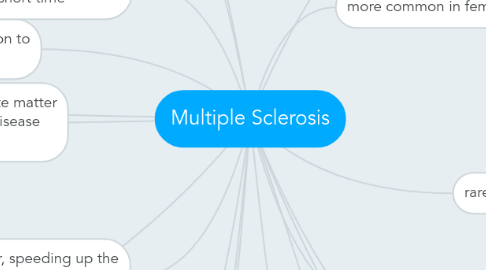
1. onset in adults > 50 years is rare
2. Indcidence of MS increases further away from the equator
2.1. migration studies show that the geographical risk associated with an individual's birthplace is retained if emigration occurs after age 15. If you move prior to 15, you assume the risk of the new location.
3. immune response triggers activation of immune cells that cross the blood brain barrier
3.1. these cells activate auto antigens, producing autoimmune cytotoxic effects within CNS
3.2. friendly fire
4. myelin serves as an insulator, speeding up the conduction along nerve fibers from one node of Ranvier to another
4.1. saltatory conduction
4.2. myelin conserves energy
4.3. disruption of myelin sheath and active demyelination slows neural transmission and causes nerves to fatigue rapidly
4.4. during early stages of MS, oligodendrocytes survive
4.5. oligodendrocytes- myelin producing cells
4.6. eventually oligodendrocytes become involved
5. lesions primarily effect white matter early, grey matter later in disease process
6. highly variable from person to person
7. malignant MS- relatively rare, characterized by rapid onset and continual progression leading to disability or death within short time
7.1. Marburg disease
8. Subtypes of MS
8.1. Relapsing Remitting
8.1.1. discrete attacks
8.1.2. lack of disease progression
8.2. Secondary Progressive
8.2.1. progression to steady irreversible decline
8.2.2. progression rather than new lesions
8.3. Primary Progressive
8.3.1. disease progression and steady functional decline
8.3.2. associated with later onset
8.4. Progressive Relapsing
8.4.1. steady deterioration
9. exacerbations are defined by new and recurrent MS symptoms lasting longer than 24 hours unrelated to another etiology
9.1. exacerbating factors exist
9.1.1. important to avoid
9.1.2. overall health deterioration
9.1.3. infections
9.1.4. diseases of major organ systems
9.1.5. stress
9.2. pseudoexacerbation- temporary worsening of symptoms
9.2.1. Uthoff's syndrome- adverse reaction to heat
10. evidence must be present of damage in two areas of CNS and damage must have occurred at two separate points in time at least one month apart, other diagnoses ruled out
11. lab tests used to diagnose
11.1. MRI
11.2. EP
11.3. LP
11.4. CSF analysis
12. managing medications
12.1. corticosteroids
12.2. synthetic interferon drugs
12.3. muscle relaxants
12.4. Botox
13. an autoimmune diesease characterized by inflammation, selective demyelination and gliosis
14. typically occurs between ages 20 and 40
15. rare in children
16. more common in females
17. not an inherited disease
17.1. risk of MS increases in persons with an effected family member
17.2. may inherit a genetic susceptibility to immune system dysfunction
17.3. molecular mimicry
17.4. increased risk with vitamin D deficiency and smoking
18. gliosis- proliferation of neurological tissue within CNS and results in glial scars or plaques
18.1. thought to be main cause of permanent disability
19. benign MS- patient remains fully functional in all neurological systems 15 years after onset, 20% of cases
20. early symptoms usually include minor visual disturbances, parathesias progressing to numbness, weakness, fatiguability
21. Common symptoms
21.1. parathesias
21.2. pain
21.2.1. Lhermitte's sign
21.2.2. paroxysmal limb pain
21.2.2.1. most common type of pain in MS
21.2.2.2. abnormal burning, aching pain
21.2.2.3. worse at night and after exercise
21.2.3. neuropathic pain
21.2.3.1. spinothalamic tracts
21.3. visual
21.3.1. optic neuritis
21.3.2. scotoma
21.3.3. Marcus Gunn pupil
21.3.4. nystagmus
21.3.5. diplopia
21.4. UMN syndrome
21.4.1. paresis, spasticity, brisk tendon reflexes, involuntary flexor and extensor spasms, clonus, Babinski's sign
21.5. reduced muscle strength, power, and endurance
21.5.1. paresis to total paralysis
21.6. spasticity
21.6.1. results in fatigue, impaired mobility, impaired ADL's, pain, contractors, abnormal posturing, poor skin integrity, falls
21.6.2. can be exacerbated by fatigue, stress, overheated, infections, pain
21.7. faigue
21.7.1. result of central activation failure
21.8. ataxia, postural and intention tremors, hypotonia, truncal weakness
21.9. difficulty walking
21.9.1. often mistaken as drunkeness
21.10. dysarthria, dysphonia, dysphagia, aspiration pneumonia
21.11. cognitive
21.12. clinical depression
21.13. emotional incontinence
21.14. bowel and bladder
21.14.1. pyramidal tract involvement
21.14.2. spasticity of pelvic floor
